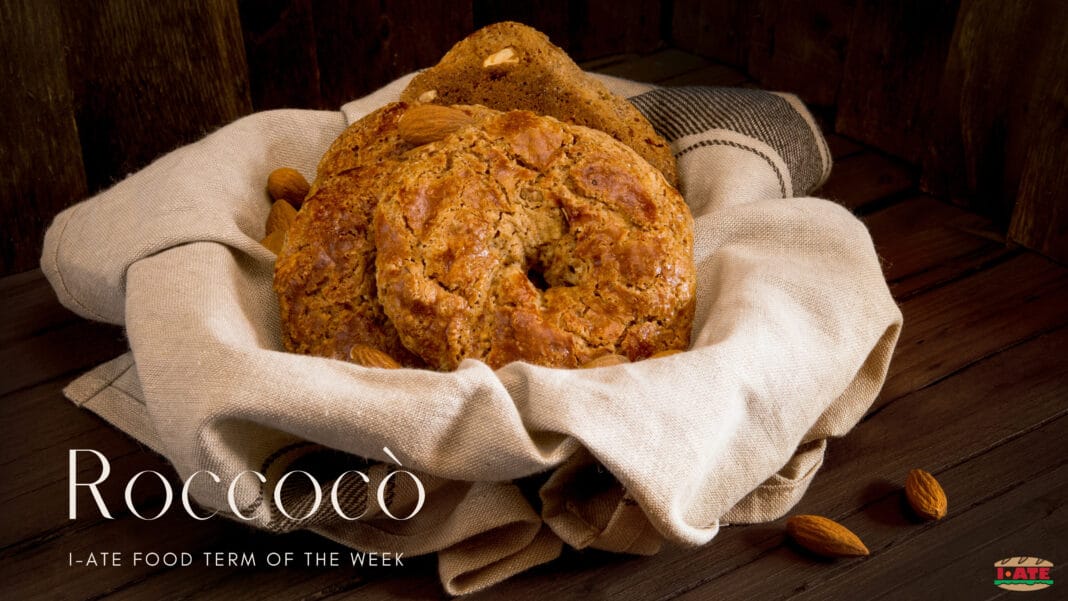Roccocò can be considered as the hardest and the most durable cake among all the Neapolitans Christmas cookies: it is a crunching rock monolith covered with a mixture of whole almonds made to last from Advent until Epiphany. It looks like a dark squashed doughnut, flavourful and crunchy, made of flour, sugar, candied fruit peels, almonds and a spice mixture called pisto, which is the real secret of each pastry chef. It is made of different amounts of nutmeg, cloves, cinnamon and coriander ground in a fine powder.
Roccocò is part of the range of cookies that usually enriches Neapolitan tables during this period of the year and it is one of the most appreciated, despite the fact that it can be very hard to break and chew. It is a real pleasure to see all those dry pastries disposed in colourful and tasty lines shown in every window shop of Neapolitan patisseries. The names of all those cookies fall down like an avalanche of sweetness: roccocò, mostaccioli, susamielli, struffoli, divino amore, raffioli, esse nasprata.

They are part of a big family of Italian pastries that the nuns once used to prepare in the nunneries all around the peninsula. In fact, for them was very easy to find many spices and exotics ingredients, thanks to the link between the monarchs of Naples with France and particularly due to the commercial exchanges with the Eastern merchants. Those pastries represented a great present for benefactors and authorities. Today they are the best way to end up a rich holiday lunch with a glass of Marsala or Vin Santo as an accompaniment, sometimes preferred to a liqueur or a glass of red wine, the way our grandparents loved to do in the past times.
The word Roccocò comes from the French word rocaille, which literally stands for an artificial rock and it also denotes the name of an ornamental style that reproduces natural elements. This is probably due to its shape similar to a stone or a shell, and its hard texture. However, even though, the two terms Roccocò and Rococò have the same origin, our delicious dry pastry is older than the artistic movement, born in France in the 18th century. In fact, the original recipe was conceived with a different name in 1320 by the nuns of the Real Convento della Maddalena in Naples, founded by Sancha d’Aragona, queen of Jerusalem and wife of King Carlo d’Angiò, to save young and poor girls from prostitution. Even if the nunnery was finally destroyed in 1955, nowadays all the bakeries and pastries in Naples produce tons of Roccocò to delight our senses, also in a soft version that shocks the purists of the tradition.
Since they are deeply rooted in their food culture, at Christmas time many Neapolitans love to arrange homemade Roccocò, filling their homes and the entrance halls with their delicious smell. For a sensational tasting in the name of tradition, there is nothing better than a stroll through the very throbbing city centre, looking at the colourful windows of celebrated patisseries. A few minutes walking from the area where the old Real Convento della Maddalena was located and this delicacy was created, you will find the old Pasticceria Carraturo at Porta Capuana, founded in 1837 and managed by the same family since then! Obviously, they keep on following the original recipe, by producing exclusively the tough Roccocò as the tradition demands. Another must-try is Di Costanzo in the Sanità district or the old Scaturchio at the Pignasecca.
Resources
Larousse. 2020. Rocaille. [ONLINE] Available at: https://tinyurl.com/yaj94vql. [Accessed 17 December 2020].
Marie Claire. 2020. Roccocò napoletani, i napoletani hanno creato i biscotti di Natale più buoni d’Italia?.
[ONLINE] Available at: https://www.marieclaire.com/it/food/a34597969/roccoco-storia-ricetta/. [Accessed 17 December 2020].
Osteria da Carmela. 2016. The Cult of the Immaculate Conception in Naples and the Tradition of Rococo. [ONLINE] Available at: https://www.osteriadacarmela.it/en/2016/11/17/napoli-il-culto-dell-immacolata-e-i-roccoco/. [Accessed 17 December 2020].
Positano News. 2019. Roccocò: il dolce del Natale nato dalle monache Maddalene. [ONLINE]
Available at: https://www.positanonews.it/2019/12/roccoco-dolce-del-natale-nato-dalle-monache-maddalene/3348461/.
[Accessed 17 December 2020].
Regione Campania Assessorato Agricoltura. 2019. Roccocò. [ONLINE]
Available at: http://agricoltura.regione.campania.it/Tipici/tradizionali/roccoco.htm. [Accessed 17 December 2020].
Scatti di Gusto. 2016. I roccocò originali, morbidi o duri, li fai con questa ricetta. [ONLINE]
Available at: https://www.scattidigusto.it/2016/12/16/roccoco-ricetta-originale-perfetta/. [Accessed 17 December 2020].
Teleradio-News. 2019. Il Real Convento della Maddalena e il Roccocò. [ONLINE]
Available at: https://www.teleradio-news.it/2019/12/29/il-real-convento-della-maddalena-e-il-roccoco/.
[Accessed 17 December 2020].
Treccani. 2020. Rocaille. [ONLINE] Available at: https://www.treccani.it/enciclopedia/rocaille/. [Accessed 17 December 2020].
Written by Cristina Carraturo,
PhD student in “European Languages and Specialized Terminology” at the University of Naples “Parthenope” (Italy).

